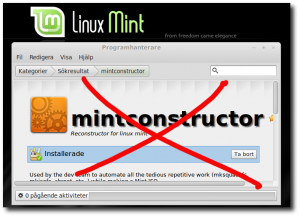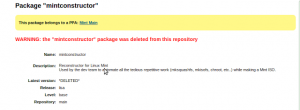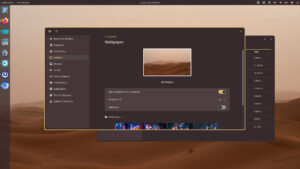It’s no great secret that our organization Reglue uses Linux Mint on many of our outgoing computers. I run Mint on one of my work computers and at home as well. Linux Mint has given us the opportunity to create a respin for educational purposes within our non profit, largely due to an app named mintConstructor. It provides a fairly simple method of making custom systems using Linux Mint as the base.
We have tried to use UCK (Ubuntu Customization Kit) to do so but it can be a hit or miss thing when attempting a respin via a derivative of Ubuntu. mintConstructor works much better.
 With our decision to move Reglue to KDE, I looked the landscape over and decided that the Mint KDE LTS version would be best suited for our needs. Friend and Google Plus buddy Randy Noseworthy took the contract for putting together our new LTS release for Reglue. It wasn’t long until Randy contacted me via email and gave me some bad news.
With our decision to move Reglue to KDE, I looked the landscape over and decided that the Mint KDE LTS version would be best suited for our needs. Friend and Google Plus buddy Randy Noseworthy took the contract for putting together our new LTS release for Reglue. It wasn’t long until Randy contacted me via email and gave me some bad news.
“mintConstructor has been pulled from the repos.”
“Surely not”, I thought to myself. That didn’t sound right and I mentioned so in my G+ stream. It wasn’t long before someone in my circles came up with the answer. Homer Slated posted the following to my inquiry:
“The reason we no longer distribute it is because it’s hurting our project much more than it’s helping a few people in our community remaster Mint for their personal needs. The reason it happened overnight was because, apparently, we released two editions we never worked on (Studio Edition and Dewdrop). Some people used our name, logos and identity to promote their own products” ~ Clement Lefebvre, Mint founder.
As it often happens, a few ruined it for many. We have used Linux Mint for a number of years at Reglue. Hundreds of kids have been introduced to computing via Linux Mint. Trying to install the additional packages on each computer was killing us time-wise. We place anywhere from 100 – 300 computers a year. When we can automate or cut down the time a machine is on the bench, the better off everyone is. That’s why mintConstructor is so important. At least to us.
Randy dug around on his hard drive, and fortunately, was able to locate an older working .deb file which he used to finish the Reglue respin, using KDE Mint as the base. We should be good until 2017, when the LTS is no longer supported.
Of course, we’ve altered nothing but the packages that are included with the Mint system ISO. The Mint branding remains throughout the entire system, as does the revenue-creating search options via Yahoo and DuckDuckGo. I think the most invasive thing we’ve done is make a Reglue desktop wallpaper available in the rotation. We will be making that ISO available shortly for anyone to use and critique.
But several people have raised a question. When is FOSS not Free? Apparently, when the creator says so, or so it would seem. Does pulling a seemingly important developers’ app reflect on Clem Lefebvre and Mint in general? Personally, I believe it’s a survivable mistake, but one that will cost Clem some geek cred.
Homer shared his opinion on the matter, and many responded in kind:
“What a bizarre attitude for a supposed Free Software developer. Lefebvre should count himself lucky that Torvalds doesn’t take a similar attitude toward his unlicensed use of the word ‘Linux’ (yes, it’s trademarked).
“No wonder you’re having such difficulty. The tools you need are not simply missing, they’ve been deliberately removed and prohibited, for reasons that should never, ever have anything to do with Free Software.”
Lefebvre says that’s not so.
“mintConstructor is, was, will, and always will be GPL. It’s available from various sources on the Internet already and anyone who has it is welcome and able to distribute it or to fork it under a new name. That is the essence of open source and we all agree that this is a wonderful thing. The life span of an open source project doesn’t stop when it is no longer developed. This is what happened here, Linux Mint will no longer distribute, develop or promote this tool. Its licensing won’t change though and I’m sure other developers will take the relay.”
I can’t validate it’s available from “various sources,” but we were able to locate a source of the software on Github without much trouble.
 Some have argued that Lefebvre did the same thing when he created Mint from the Ubuntu base. I don’t think that’s entirely correct but I see how this might be a justified opinion, at first blush anyway. Clem never branded his distro as “Ubuntu” or any “buntu” for that matter. Clem felt that his hard work was being threatened by these other projects and took steps to make sure it didn’t happen again.
Some have argued that Lefebvre did the same thing when he created Mint from the Ubuntu base. I don’t think that’s entirely correct but I see how this might be a justified opinion, at first blush anyway. Clem never branded his distro as “Ubuntu” or any “buntu” for that matter. Clem felt that his hard work was being threatened by these other projects and took steps to make sure it didn’t happen again.
Would issuing a public warning to the offending parties have worked better? I mean instead of eradicating the program completely from the repositories? I’m inclined to say it would. But then again, purging all known links and mention of the application from your website in less than 24 hours sends a pretty strong message as well. When something like this happens as quickly as this did, and without any discussion or warning, that can be perceived as drastic. It most certainly has been cause for all sorts of conjecture.
Babies, bathwater and all of that.
Someone close to me equated this to a child who got his feelings hurt and grabbed up his ball and went home, as is often seen in playground disputes.
“If you’re not gonna play by my rules, no one will play.”
I can understand Clem’s reaction to a point. He’s worked for years to achieve the success he and the Mint team enjoy. Of course he feels invested in his work and understandably protective. Lefebvre explains in more detail:
“Regarding branding issues themselves, we’re getting in touch with the maintainer of Linux Mint Studio and he accepted to rename and re-brand his work under a different name. We got no news from ‘Dewdrop’… As a rule of thumb we like to encourage everyone to use the technology we develop (i.e. our packages, repositories and tools) but to also discourage people from using our name, logos, artwork and branding. Ideally, we want to share everything we do, but we don’t want anyone else but us to call themselves ‘Linux Mint.’ It’s our identity.”
This tool may have been removed from all presence and mention from the Mint Project, but it is still available elsewhere, and that’s a good thing.
Personally, I will argue that bringing the offenders into the cold light of millions of computer monitors would have been a better solution. If someone is going out of their way to use your name and reputation, you are doing something right. People are always going to try to copy you if you produce a superior product. Publicly outing them could probably do more harm to their efforts than anything else.
And sure, it probably would devolve into a public squabble that would distract everyone from their duties. Clem possibly did what he did in order to avoid that in particular. Trust me on this one, I’ve been caught up in what should have been a local squabble which ended up going viral. It can get ugly fast, but people will most always side with those that are in the right. Clem Lefebvre believes he is on the right side of this issue.
There are hundreds of Central Texas kids that have benefited personally from Clem Lefebvre’s work; I know that for a fact. Now multiply that by a few hundred times. Times you will never know about. Times when a tool was forged to do a task no other tool could — a tool mighty enough to change the course of a human being’s life. Be it in Boise or Burma, the ability to tailor an operating system to the student’s specific needs is a massively powerful tool to possess.
With that in mind, others took it upon themselves to find instances of mintConstructor via the Wayback Machine and seeded those files in other places. That .deb file and source are now in greater circulation and will be a bit easier to find. In their mind, they are doing the right thing.

It appears that someone was able to find it and bend it enough to meet their own needs. At this point, I am not sure removing it from the Mint repositories did anything but inconvenience people who were looking for it at that particular time. People who needed that file had to actually go look for it.
And yeah, to some this incident had all the look and feel of a power play. Folks know one when they see one and power plays are not always noted in a positive light. But neither is identifying someone else’s work as your own.
My guess is that this current release of mintConstructor will not be updated, at least by anyone from the Mint team. Unless someone can keep up with future Mint releases, this is the end of the line so to speak. That’s fine. I’ve actually been able to create a Mint KDE respin from UCK, but I had to use the Tasksel solution as the Synaptic method crashed the whole project. Live and learn. That’s the beauty of open source, something will take the place of something removed if it’s important to the right people.
I think we are the right people.
Free open source software is a spark that ignites the flame of knowledge, education and growth, especially within the Linuxsphere. So maybe this is an extremely small instance. Maybe in the grand scheme, it’s not that important. Whether it is or not, I am glad that the pieces could be swept up, repaired and put back into service. Maybe a little girl in Burma will be inspired to be the first doctor or scientist in her family.
Ken Starks is the founder of the Helios Project and Reglue, which for 20 years provided refurbished older computers running Linux to disadvantaged school kids, as well as providing digital help for senior citizens, in the Austin, Texas area. He was a columnist for FOSS Force from 2013-2016, and remains part of our family. Follow him on Twitter: @Reglue







I’m sorry these things happen. Having somebody appropriate your trademark can be problem and it can be a legal issue. (Would you hand me a Kleenex? They’re in the box over there. Says “Scott” on the side.) When you try to defend it, it may look strange or worse. (Hey, Linux is free. Mint is free. What’s wrong with using it and using the brand name? Yeah, right.)
I’m a cash contributor to Reglue and a cash contributor to Mint. It hurts me that Ken & Co. are spending time fighting with a minor (I hope) software issue when I’d like them to be doing work that directly benefits the young people. I’m not thrilled that Clem is defending a trademark, rather than working on making Mint better for me and for others.
I just sent Mint another donation and now I’m going to send Clem a note asking him to reconsider. For all I know, he may have been warned by his/Mint’s lawyer that there could be a problem if he didn’t do something about it and he/they decided this was the best way.
Doesn’t hurt to ask.
Clem Lefebvre is a spoiled brat. I don’t/won’t and never will recommend mint to anyone, I stopped using Mint years ago, over his attitude to the mint community Zorin puts mint to shame and so do many other smaller distributions
Build Debian stable (and select done backports) to what you like in Mint, or what have you. One desktop manager at a time. Not Gnome 3! Don’t use hardware devices with less power than someone will give you.
Mint is for underachiving tech types who are impatint. I respect that may be good for adoption. But you might as well go Debian. because you’d still have to “fix up” Mint, for your own brand of custom.
Installing is an unfair investment in our current reality of anticompetivness. Installing Debain is worth it. Installing may require a few tries, new(ish) device(your preference) changes and time exploring what you want, amoung much good choice. However, installing is not using. An initial install/booting doesn’t count as real, compleate installing, for you and your sepcific needs.
The irony is, once a total system is installed then app/program installs (and ongoing managment) is the least of evils by far.
Mint is best for playing with it (seeing one setup of GNU/Linux), after 20 minutes of loading.
If you belive Apple, go and learn how they lie. This is not about preferrence, it’s your freedom. Working handcuffs are not better than temporary raodblocks to finding your freedom. It works. The myths are thick. beware the half-“truths”. Then install Debian; before it’s taken away from you, by force.
Have you tried fsarchiver?
“FSArchiver is a system tool that allows you to save the contents of a file-system to a compressed archive file. The file-system can be restored on a partition which has a different size and it can be restored on a different file-system. Unlike tar/dar, FSArchiver also creates the file-system when it extracts the data to partitions. Everything is checksummed in the archive in order to protect the data. If the archive is corrupt, you just loose the current file, not the whole archive. Fsarchiver is released under the GPL-v2 license. You should read the Quick start guide if you are using FSArchiver for the first time.”
Nice article, I started on Linux Mint, but I’m about to start a non-profit, quite like the one you run. My choice of OS is Fedora though. I have a, almost working, installation of Spacewalk running. With this, I’ll be able to control the computers I’ll be giving to children whom need them, pushing software, updates, even PXE booting if needed (although I’ll try to do this locally most of the time).
I’ll also be able to deploy CentOS and any other RedHat based server (Debian is capable of working with Spacewalk, although I haven’t started to try yet). If you’d like me to get you some documentation of what I’m doing and how, please let me know.
Look into SolydK BE. SolydK has a version of Constructor they use and make available for you. SolydK Business Edition is based on Debian Stable and would make a great base for your project.
If Clem created this product and licensed it the way he did then I see nothing wrong with his actions. There is no law in the open source world that chains Clem to this tool and obligates him to maintain it in perpetuity and then schedule his time around dealing with crises resulting from its use.
The source for this tool is out there, so if somebody wants to continue using it then they are welcome to fork the project and maintain their own version.
SolydK could be an excellent fit for Reglue. Talk to Schoelje.
http://solydxk.com/about/the-solydxk-team/
@Uncle Geek – regarding your comment:
” For all I know, he may have been warned by his/Mint’s lawyer that there could be a problem if he didn’t do something about it and he/they decided this was the best way.”
I wonder if Linux Mint really has a legal leg to stand on with all this? I think the real problem for them may be that they don’t have much of a legal leg to stand on right now – and pulling Constructor was the only thing they could do, short term, to do… what I don’t know.
A couple of things worth pointing out here. Linux Mint claims copyright and trademark as follows on the bottom of their homepage:
“Linux Mint is copyrighted 2006 and trademarked through the Linux Mark Institute”
Two points:
1) I’m not sure what it is they’ve copyrighted since brand names or service marks aren’t covered by copyright law. That’s what registered trademarks and service marks are for. Perhaps they meant it’s the logo *artwork* which has been copyrighted?
2) The only thing the Linux Mark Institute does is sublicense YOUR use of the word “Linux” (which is a registered trademark btw) as part of YOUR distro. It does not trademark your entire distro name as Linux Mint seems to infer. You need to file an application with the USPTO (or your own national equivalent) to get an actual trademark for your own distro name.
I think when Constructor was pulled, Linux Mint probably didn’t have a trademark on their name. And that probably came as a complete surprise to them had they contemplated legal action and then spoken to a competent attorney. You see this all the time with something small and informal that suddenly becomes a big thing. All those little legal details (registrations, trademarks, patents, etc.) got neglected because the project was “just for fun” or “for the sake of the art.” But later on, when your project starts getting serious, those earlier oversights suddenly turn around and bite you on the ass.
I think Linux Mint is in a somewhat similar position and probably scrambling to get all the legalities and formalities squared away right now. Ideally before somebody bigger (or with money) scents an opportunity and tries to get in ahead of them and claim the name first.
Like the old saying goes: nothing can kill something faster than its sudden success. And nothing attracts sharks more quickly than the scent of blood in the water.
I wish Linux Mint luck. It is a nice distribution.